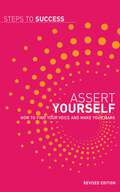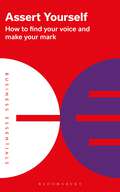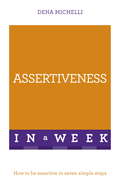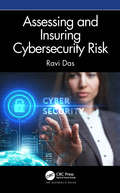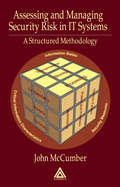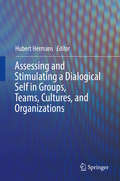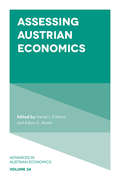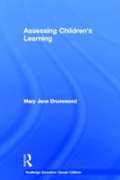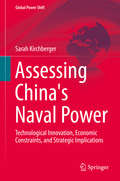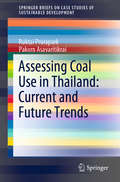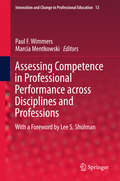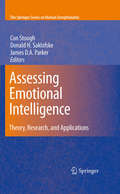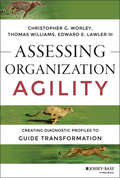- Table View
- List View
Assembly Line Planning and Control
by Nick T. ThomopoulosAssembly Line Planning and Control describes the basic fundamentals of assembly lines for single model lines, mixed model make-to-stock lines, mixed model make-to-order lines and for one-station assembly. The book shows how to select the quantity of units to schedule for a shift duration, compute the number of operators needed on a line, set the conveyor speed, coordinate the main line with sub-assembly lines, assign the work elements to the operators on the line, sequence the models down the line, sequence the jobs down the line, calculate the part and component requirements for a line and for each station, determine the replenish needs of the parts and components from the suppliers, compute the similarity between the models being produced and show applications, use learning curves to estimate time and costs of assembly, and measure the efficiency of the line. The material is timeless and the book will never become obsolete. The author presents solutions with easy-to-understand numerical examples that can be applied to real-life applications.
Assert Yourself: How to Find Your Voice and Make Your Mark (Steps to Success)
by Bloomsbury PublishingDo you find it hard to say 'no'? Are you tongue-tied in important meetings? Assert Yourself will help you find your voice and stand up for yourself without appearing aggressive.Full of practical advice on how to change the way you work and livefor the better, the book contains a self-assessment quiz, step-by-stepguidance, top tips, common mistakes and advice on how to avoid them,summaries of key points, and lists of handy books and websites.
Assert Yourself: How to find your voice and make your mark (Business Essentials)
by Bloomsbury PublishingThe essential guide to making your voice heard and having your efforts recognised.Do you find it hard to say 'no'? Are you tongue-tied in important meetings? Bored of 'mansplaining' when you know that you're the best qualified person on a particular topic? Understanding the difference between being assertive and being aggressive can be a crucial lesson on your career journey, and Assert Yourself can help you find your voice and stand up for yourself.Full of practical advice on how to change the way you work and live for the better, the book contains a self-assessment quiz, step-by-step guidance, top tips, common mistakes and advice on how to avoid them, and summaries of key points.
Assert Yourself: How to find your voice and make your mark (Business Essentials)
by Bloomsbury PublishingThe essential guide to making your voice heard and having your efforts recognised.Do you find it hard to say 'no'? Are you tongue-tied in important meetings? Bored of 'mansplaining' when you know that you're the best qualified person on a particular topic? Understanding the difference between being assertive and being aggressive can be a crucial lesson on your career journey, and Assert Yourself can help you find your voice and stand up for yourself.Full of practical advice on how to change the way you work and live for the better, the book contains a self-assessment quiz, step-by-step guidance, top tips, common mistakes and advice on how to avoid them, and summaries of key points.
Assertiveness: How To Be Strong In Every Situation
by Conrad Potts Suzanne PottsHow to overcome challenges with confidence No matter how successful we are, we all face stressful and hard-to-handle challenges in daily life, and – if we want to be as happy and healthy as we can – we must learn to assert ourselves, make our voices heard and approach life with confidence and self-assurance. This book is a roadmap to help you navigate your way through those challenging opportunities, hurdles and milestones. Taking universal scenarios case by case, and packed with practical tips, this inspiring, down-to-earth book will give you the tools to build your self-esteem and become happier, healthier, and in control of your own destiny. Written in an approachable style which posits practical solutions to a range of universal problems Deals with assertiveness in business, family, social situations and all areas of life Covers topics like ‘dealing with your boss’, ‘dealing with finances’, ‘asking for a pay rise’, ‘saying no at work’
Assertiveness: How To Be Strong In Every Situation
by Conrad Potts Suzanne PottsHow to overcome challenges with confidence No matter how successful we are, we all face stressful and hard-to-handle challenges in daily life, and – if we want to be as happy and healthy as we can – we must learn to assert ourselves, make our voices heard and approach life with confidence and self-assurance. This book is a roadmap to help you navigate your way through those challenging opportunities, hurdles and milestones. Taking universal scenarios case by case, and packed with practical tips, this inspiring, down-to-earth book will give you the tools to build your self-esteem and become happier, healthier, and in control of your own destiny. Written in an approachable style which posits practical solutions to a range of universal problems Deals with assertiveness in business, family, social situations and all areas of life Covers topics like ‘dealing with your boss’, ‘dealing with finances’, ‘asking for a pay rise’, ‘saying no at work’
Assertiveness and Diversity
by A. TownendThe book explores the relationship between assertiveness and diversity. The case studies and personal stories illustrate how individuals, teams, and organizations can make a difference and make it possible for everyone to be valued for who they are respected for what they do.
Assertiveness In A Week: How To Be Assertive In Seven Simple Steps (TYW)
by Dena Michelli'A useful confidence-building tool for those whose key aim is to find their inner power' Edge OnlineBeing more assertive just got easierMuch has been spoken about the assertive communication style, not all of it complimentary! Many people confuse it with being aggressive, bamboozling others into submission and getting what you want, despite what they want. However, assertive communication is not domineering; it's just a means of saying what you mean, meaning what you say and allowing others to do the same.Taking the decision to adopt assertive behaviour will mark the beginning of a new way of life: a way of life where you make your own decisions and choices without feeling guilty, and where you are in control, not those around you.By working through some simple steps, and by testing the techniques out in a 'safe' environment, you will soon become confident in your new-found powers of assertion. You will be able to command the respect of others, achieve your personal and professional goals and raise your self-esteem.The steps to assertive behaviour you will cover in this book are:- Understand the different styles of communication and the effect they have.- Identify your own style(s) of communication.- Know your own worth and the worth of others.- Be clear about your goals.- Be prepared to learn from your successes and failures.- Be flexible, and don't expect too much.- Learn to listen.Each of the seven chapters in Assertiveness In A Week covers a different aspect of being assertive:- Sunday: Preparing the foundations- Monday: Creating winning scenarios- Tuesday: Dealing with the 'negative'- Wednesday: Creating a positive impression- Thursday: Being assertive in public- Friday: Body language- Saturday: Personal power
Assess and Analyze: Discovering the Waste Consuming Your Profits (BASICS Lean® Implementation)
by Charles Protzman Fred Whiton Joyce KerpcharLean is about building and improving stable and predictable systems and processes to deliver to customers high-quality products/services on time by engaging everyone in the organization. Combined with this, organizations need to create an environment of respect for people and continuous learning. It’s all about people. People create the product or service, drive innovation, and create systems and processes, and with leadership buy-in and accountability to ensure sustainment with this philosophy, employees will be committed to the organization as they learn and grow personally and professionally. Lean is a term that describes a way of thinking about and managing companies as an enterprise. Becoming Lean requires the following: the continual pursuit to identify and eliminate waste; the establishment of efficient flow of both information and process; and an unwavering top-level commitment. The concept of continuous improvement applies to any process in any industry. Based on the contents of The Lean Practitioners Field Book, the purpose of this series is to show, in detail, how any process can be improved utilizing a combination of tasks and people tools and introduces the BASICS Lean® concept. The books are designed for all levels of Lean practitioners and introduces proven tools for analysis and implementation that go beyond the traditional point kaizen event. Each book can be used as a stand-alone volume or used in combination with other titles based on specific needs. Each book is chocked full of case studies and stories from the authors’ own experiences in training organizations who have started or are continuing their Lean journey of continuous improvement. Contents include valuable lessons learned and each chapter concludes with questions pertaining to focus of the chapter. Numerous photographs enrich and illustrate specific tools used in Lean methodology. BASICS Lean® Assess/Analyze: A Guide to Process Flow Analysis, Work Flow Analysis, and Changeover Analysis explores the tools used to assess and analyze the process. It includes the three tools: mapping the product flow, documenting the full work of the operator and implement SMED or changeover reduction.
Assess and Analyze: Discovering the Waste Consuming Your Profits (BASICS Lean® Implementation)
by Charles Protzman Fred Whiton Joyce KerpcharLean is about building and improving stable and predictable systems and processes to deliver to customers high-quality products/services on time by engaging everyone in the organization. Combined with this, organizations need to create an environment of respect for people and continuous learning. It’s all about people. People create the product or service, drive innovation, and create systems and processes, and with leadership buy-in and accountability to ensure sustainment with this philosophy, employees will be committed to the organization as they learn and grow personally and professionally. Lean is a term that describes a way of thinking about and managing companies as an enterprise. Becoming Lean requires the following: the continual pursuit to identify and eliminate waste; the establishment of efficient flow of both information and process; and an unwavering top-level commitment. The concept of continuous improvement applies to any process in any industry. Based on the contents of The Lean Practitioners Field Book, the purpose of this series is to show, in detail, how any process can be improved utilizing a combination of tasks and people tools and introduces the BASICS Lean® concept. The books are designed for all levels of Lean practitioners and introduces proven tools for analysis and implementation that go beyond the traditional point kaizen event. Each book can be used as a stand-alone volume or used in combination with other titles based on specific needs. Each book is chocked full of case studies and stories from the authors’ own experiences in training organizations who have started or are continuing their Lean journey of continuous improvement. Contents include valuable lessons learned and each chapter concludes with questions pertaining to focus of the chapter. Numerous photographs enrich and illustrate specific tools used in Lean methodology. BASICS Lean® Assess/Analyze: A Guide to Process Flow Analysis, Work Flow Analysis, and Changeover Analysis explores the tools used to assess and analyze the process. It includes the three tools: mapping the product flow, documenting the full work of the operator and implement SMED or changeover reduction.
Assessing and Insuring Cybersecurity Risk
by Ravi DasRemote workforces using VPNs, cloud-based infrastructure and critical systems, and a proliferation in phishing attacks and fraudulent websites are all raising the level of risk for every company. It all comes down to just one thing that is at stake: how to gauge a company’s level of cyber risk and the tolerance level for this risk. Loosely put, this translates to how much uncertainty an organization can tolerate before it starts to negatively affect mission critical flows and business processes. Trying to gauge this can be a huge and nebulous task for any IT security team to accomplish. Making this task so difficult are the many frameworks and models that can be utilized. It is very confusing to know which one to utilize in order to achieve a high level of security. Complicating this situation further is that both quantitative and qualitative variables must be considered and deployed into a cyber risk model. Assessing and Insuring Cybersecurity Risk provides an insight into how to gauge an organization’s particular level of cyber risk, and what would be deemed appropriate for the organization’s risk tolerance. In addition to computing the level of cyber risk, an IT security team has to determine the appropriate controls that are needed to mitigate cyber risk. Also to be considered are the standards and best practices that the IT security team has to implement for complying with such regulations and mandates as CCPA, GDPR, and the HIPAA. To help a security team to comprehensively assess an organization’s cyber risk level and how to insure against it, the book covers: The mechanics of cyber risk Risk controls that need to be put into place The issues and benefits of cybersecurity risk insurance policies GDPR, CCPA, and the the CMMC Gauging how much cyber risk and uncertainty an organization can tolerate is a complex and complicated task, and this book helps to make it more understandable and manageable.
Assessing and Insuring Cybersecurity Risk
by Ravi DasRemote workforces using VPNs, cloud-based infrastructure and critical systems, and a proliferation in phishing attacks and fraudulent websites are all raising the level of risk for every company. It all comes down to just one thing that is at stake: how to gauge a company’s level of cyber risk and the tolerance level for this risk. Loosely put, this translates to how much uncertainty an organization can tolerate before it starts to negatively affect mission critical flows and business processes. Trying to gauge this can be a huge and nebulous task for any IT security team to accomplish. Making this task so difficult are the many frameworks and models that can be utilized. It is very confusing to know which one to utilize in order to achieve a high level of security. Complicating this situation further is that both quantitative and qualitative variables must be considered and deployed into a cyber risk model. Assessing and Insuring Cybersecurity Risk provides an insight into how to gauge an organization’s particular level of cyber risk, and what would be deemed appropriate for the organization’s risk tolerance. In addition to computing the level of cyber risk, an IT security team has to determine the appropriate controls that are needed to mitigate cyber risk. Also to be considered are the standards and best practices that the IT security team has to implement for complying with such regulations and mandates as CCPA, GDPR, and the HIPAA. To help a security team to comprehensively assess an organization’s cyber risk level and how to insure against it, the book covers: The mechanics of cyber risk Risk controls that need to be put into place The issues and benefits of cybersecurity risk insurance policies GDPR, CCPA, and the the CMMC Gauging how much cyber risk and uncertainty an organization can tolerate is a complex and complicated task, and this book helps to make it more understandable and manageable.
Assessing and Managing Security Risk in IT Systems: A Structured Methodology
by John McCumberThis book begins with an overview of information systems security, offering the basic underpinnings of information security and concluding with an analysis of risk management. Part II describes the McCumber Cube, providing the original paper from 1991 and detailing ways to accurately map information flow in computer and telecom systems. It also explains how to apply the methodology to individual system components and subsystems. Part III serves as a resource for analysts and security practitioners who want access to more detailed information on technical vulnerabilities and risk assessment analytics. McCumber details how information extracted from this resource can be applied to his assessment processes.
Assessing and Managing Security Risk in IT Systems: A Structured Methodology
by John McCumberThis book begins with an overview of information systems security, offering the basic underpinnings of information security and concluding with an analysis of risk management. Part II describes the McCumber Cube, providing the original paper from 1991 and detailing ways to accurately map information flow in computer and telecom systems. It also explains how to apply the methodology to individual system components and subsystems. Part III serves as a resource for analysts and security practitioners who want access to more detailed information on technical vulnerabilities and risk assessment analytics. McCumber details how information extracted from this resource can be applied to his assessment processes.
Assessing and Stimulating a Dialogical Self in Groups, Teams, Cultures, and Organizations
by Hubert HermansThis book presents 9 theory-based and practice-oriented methods for assessing and stimulating a multi-voiced dialogical self in the context of groups, teams, cultures, and organizations. All of these methods are based on Dialogical Self Theory. The book deals with the practical implications of this theory as applied in the areas of coaching, training, and counselling. A number of chapters focus on the process of positioning and dialogue on the level of the self, while other chapters combine self-processes with group work, and still others find their applications in leadership development and team-work in organizations. For each of the nine methods, the chapters present theory, method, case-study and discussions and make clear what kind of problems can be tackled using the method discussed. Specifically, the book discusses the following methods: A Negotiational Self Method for assessing and solving inner conflicts; a Self-Confrontation Method used to assess and stimulate personal meaning construction in career counselling; a Method of Expressive Writing in the context of career development; a Composition Method for studying the content and organization of personal positions via verbal and non-verbal procedures; a Dialogical Leadership Method that investigates and stimulates dialogical relationships between personal positions in the self of leaders in organizations; a Personal Position Repertoire Method that combines the assessment of personal positions with focus group discussions; a Team Confrontation Method for investigating collective and deviant positions or voices in organizational teams; a Method for Revising Organizational Stories with a focus on their emotional significance: and a Technique for Assessing and Stimulating Innovative Dialogue between Cultural Positions in global nomads.
Assessing Austrian Economics (Advances in Austrian Economics #24)
by Daniel J. D'Amico Adam G. MartinThe modern school of Austrian economics took shape in the 1970s, and reflects the social science questions of its time. Is it still relevant today, considering that the theories that drive contemporary social science have evolved dramatically over the past few decades? While Austrian concerns such as property rights and imperfect cognition have become more common, other aspects of the Austrian thought are even more idiosyncratic than ever. In the ten chapters included here, leading economists explore whether Austrian economics still has unique insights to offer the world of today. Starting with Peter Boettke’s lead essay, “What is Wrong with Austrian Economics?”, chapters include an array of perspectives responding to this question, ranging from economics, to intellectual history, to political science, and to philosophy. At the end of the volume, Boettke offers a rejoinder, asking, “What is Right About Austrian Economics?” Together, these essays explore the barriers to the spread of Austrian ideas, ask which disciplines might be receptive to them, examine the role of ideology and funding in helping and hindering the school, and consider the advantages and disadvantages of different strategies for expanding engagement with other scholars.
Assessing Austrian Economics (Advances in Austrian Economics #24)
by Daniel J. D’Amico Adam G. MartinThe modern school of Austrian economics took shape in the 1970s, and reflects the social science questions of its time. Is it still relevant today, considering that the theories that drive contemporary social science have evolved dramatically over the past few decades? While Austrian concerns such as property rights and imperfect cognition have become more common, other aspects of the Austrian thought are even more idiosyncratic than ever. In the ten chapters included here, leading economists explore whether Austrian economics still has unique insights to offer the world of today. Starting with Peter Boettke’s lead essay, “What is Wrong with Austrian Economics?”, chapters include an array of perspectives responding to this question, ranging from economics, to intellectual history, to political science, and to philosophy. At the end of the volume, Boettke offers a rejoinder, asking, “What is Right About Austrian Economics?” Together, these essays explore the barriers to the spread of Austrian ideas, ask which disciplines might be receptive to them, examine the role of ideology and funding in helping and hindering the school, and consider the advantages and disadvantages of different strategies for expanding engagement with other scholars.
Assessing Business Excellence: A Guide To Business Excellence And Self-assessment
by L. J. Porter S. J. TannerAssessing Business Excellence presents a strategic framework for business excellence and total quality management and shows how you can be actively involved in continuous improvement by systematically reviewing your business activities and results against holistic business excellence frameworks.For all practitioners who seek to use total quality management to improve their organization's effectiveness, efficiency and responsiveness, this title is the essential route map to business excellence. From two leading expert authors comes a book where the most recognized quality award criteria are used to explore the concepts of business excellence and self-assessment. This book:* Introduces the major business excellence and total quality frameworks including The Malcolm Baldrige National Quality Award and the European Quality Award and ISO9000:2000* Compares the frameworks and identifies their strengths and limitations * Introduces the self-assessment process * Explores the main approaches to self-assessment * Illustrates the practical benefits of self-assessment through case examples
Assessing Business Excellence
by Les Porter Steve TannerAssessing Business Excellence presents a strategic framework for business excellence and total quality management and shows how you can be actively involved in continuous improvement by systematically reviewing your business activities and results against holistic business excellence frameworks.For all practitioners who seek to use total quality management to improve their organization's effectiveness, efficiency and responsiveness, this title is the essential route map to business excellence. From two leading expert authors comes a book where the most recognized quality award criteria are used to explore the concepts of business excellence and self-assessment. This book:* Introduces the major business excellence and total quality frameworks including The Malcolm Baldrige National Quality Award and the European Quality Award and ISO9000:2000* Compares the frameworks and identifies their strengths and limitations * Introduces the self-assessment process * Explores the main approaches to self-assessment * Illustrates the practical benefits of self-assessment through case examples
Assessing Children's Learning
by Mary Jane DrummondIn this edition Mary Jane Drummond examines some of the important questions that teachers and other educators ask themselves as they assess children's learning across the curriculum. 9780415686730 / 9780203801338
Assessing China's Naval Power: Technological Innovation, Economic Constraints, and Strategic Implications (Global Power Shift)
by Sarah KirchbergerThis book analyzes the rise of China’s naval power and its possible strategic consequences from a wide variety of perspectives – technological, economic, and geostrategic – while employing a historical-comparative approach throughout. Since naval development requires huge financial resources and mostly takes place within the context of transnational industrial partnerships, this study also consciously adopts an industry perspective. The systemic problems involved in warship production and the associated material, financial, technological, and political requirements currently remain overlooked aspects in the case of China.Drawing on first-hand working experience in the naval shipbuilding industry, the author provides transparent criteria for the evaluation of different naval technologies’ strategic value, which other researchers can draw upon as a basis for further research in such diverse fields as International Security Studies, Naval Warfare Studies, Chinese Studies, and International Relations.
Assessing Coal Use in Thailand: Current and Future Trends (SpringerBriefs on Case Studies of Sustainable Development)
by Ruktai Prurapark Pakorn AsavaritikraiThis book highlights Thailand’s growing demand for clean energy from coal. The main source of energy for electricity production in Thailand (70%) is currently natural gas. However, natural gas extraction remains limited, resulting in an increasing need to import natural gas from other countries, which in turn leads to rising prices and unstable supplies. As such, coal energy is essential for industrial use and electricity production in Thailand. The book discusses the importance of developing and implementing clean technologies for coal. It also argues that collaborations between the government, private sector and the public are vital to achieving a mutual understanding and acceptance of coal energy and clean technologies, as well as a reduction in harmful emissions.
Assessing Competence in Professional Performance across Disciplines and Professions (Innovation and Change in Professional Education #13)
by Paul F. Wimmers Marcia MentkowskiThis book examines the challenges of cross-professional comparisons and proposes new forms of performance assessment to be used in professions education. It addresses how complex issues are learned and assessed across and within different disciplines and professions in order to move the process of “performance assessment for learning” to the next level. In order to be better equipped to cope with increasing complexity, change and diversity in professional education and performance assessment, administrators and educators will engage in crucial systems thinking. The main question discussed by the book is how the required competence in the performance of students can be assessed during their professional education at both undergraduate and graduate levels. To answer this question, the book identifies unresolved issues and clarifies conceptual elements for performance assessment. It reviews the development of constructs that cross disciplines and professions such as critical thinking, clinical reasoning, and problem solving. It discusses what it means to instruct and assess students within their own domain of study and across various roles in multiple contexts, but also what it means to instruct and assess students across domains of study in order to judge integration and transfer of learning outcomes. Finally, the book examines what it takes for administrators and educators to develop competence in assessment, such as reliably judging student work in relation to criteria from multiple sources. "... the co-editors of this volume, Marcia Mentkowski and Paul F. Wimmers, are associated with two institutions whose characters are so intimately associated with the insight that assessment must be integrated with curriculum and instructional program if it is to become a powerful influence on the educational process ..." Lee Shulman, Stanford University
Assessing Emotional Intelligence: Theory, Research, and Applications (The Springer Series on Human Exceptionality)
by Donald H. Saklofske Con Stough James D.A. ParkerManaging human emotions plays a critical role in everyday functioning. After years of lively debate on the significance and validity of its construct, emotional intelligence (EI) has generated a robust body of theories, research studies, and measures. Assessing Emotional Intelligence: Theory, Research, and Applications strengthens this theoretical and evidence base by addressing the most recent advances and emerging possibilities in EI assessment, research, and applications. This volume demonstrates the study and application of EI across disciplines, ranging from psychometrics and neurobiology to education and industry. Assessing Emotional Intelligence carefully critiques the key measurement issues in EI, and leading experts present EI as eminently practical and thoroughly contemporary as they offer the latest findings on: EI instruments, including the EQ-I, MSCEIT, TEIQue, Genos Emotional Intelligence Inventory, and the Assessing Emotions Scale. The role of EI across clinical disorders. Training professionals and staff to apply EI in the workplace. Relationships between EI and educational outcomes. Uses of EI in sports psychology. The cross-cultural relevance of EI. As the contributors to this volume in the Springer Series on Human Exceptionality make clear, these insights and methods hold rich potential for professionals in such fields as social and personality psychology, industrial and organizational psychology, psychiatry, business, and education.
Assessing Organization Agility: Creating Diagnostic Profiles to Guide Transformation (J-B Short Format Series)
by Christopher G. Worley Thomas D. Williams Edward E. Lawler IIIIn-depth agility evaluation for a more efficient response to change Assessing Organization Agility provides a clear, concise roadmap to improved implementation of change. Written by two organizational researchers at USC's Center for Effective Organizations and a management consultant with Strategy& (formerly Booz & Company), this book provides the means for assessing an organization's agility and formulating an improvement plan. Beginning with a discussion about the meaning of "agility," the authors enumerate the various contributing factors that affect how quickly an organization responds to change, and the efficiency of the response. An agility survey shows readers how their own organization compares in terms of both perception and implementation, allowing the formulation of an "Agility Profile" that can point out strengths while highlighting areas in need of improvement. Case studies demonstrate the real-world impact of effective agility strategy, and example scenarios illustrate improved responses by each agility "type." Eighty percent of large-scale organizations fail to meet their objectives, and poor agility is often to blame. Organizations respond to changes in the marketplace, economy, and society by implementing changes in their processes and procedures, but planning and implementing change takes time. During that time, the context of the initial decision frequently evolves, leaving the organization one step behind. Agility is the ability to quickly implement change without sacrificing strategy, and Assessing Organization Agility helps readers to: Discover the organizational/operational factors that contribute to agility Assess current agility from all perspectives, highlighting areas for improvement Implement processes and procedures that streamline change events Maintain forward trajectory with adjustments to strategy and implementation The current pace of technical, competitive, and environmental change is faster than ever before, and response requirements are far more complex and sophisticated. In this turbulent environment, agility can mean the difference between success and stagnation. Assessing Organization Agility asks the questions and provides the answers that lead to better organizational reflex and more effective response.

